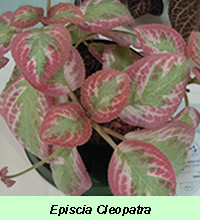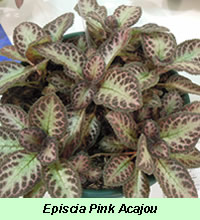Gesneriad Information
EPISCIA
 The genus Episcia (ep-ISS-ee-a) was named by the Swiss botanist Martius in 1829.
Episcia derived from the Greek word episkos meaning shade loving. Episcias are
often called Flame Violets because of the dark red flowers of some of the species.
Other species have flowers that are yellow, orange, or blue. Episcias are often
referred to as the peacocks of the Gesneriad family because of their foliage and the
The genus Episcia (ep-ISS-ee-a) was named by the Swiss botanist Martius in 1829.
Episcia derived from the Greek word episkos meaning shade loving. Episcias are
often called Flame Violets because of the dark red flowers of some of the species.
Other species have flowers that are yellow, orange, or blue. Episcias are often
referred to as the peacocks of the Gesneriad family because of their foliage and the brilliance of their flowers. Many Episcias have leaves with a metallic iridescent sheen. Others have extremely hairy leaves giving them a deep pile look. There are only ten species in the genus Episcia. They range from Southern Mexico to Brazil. The fruit of the Episcias is a fleshy capsul.
 Episcias, because of their trailing habit are well suited to hanging baskets. Episcias
can be propagated from stolons or tip cuttings. Episcias do well in a soilless mix
consisting of one part Jiffy Mix (one part peat moss to one part vermiculite) to one
part perlite. Also add a little lime to the soil. They can also be grown in long fiber
sphagnum moss. Fill 2/3 of the hanging basket or shallow pot with foam peanuts. Then place the soil mix in the upper 1/3 of the pot. Episcias have a shallow root system. Fertilize with every watering with 1/4 strength of a granular fertilizer such as
Rapid Gro. Some growers alternate weekly with a fish emulsion fertilizer. Episcias
require about the same light as an African Violet (12 - 16 hours per day). They do
well in a light garden, on the porch or in a window with filtered light. Episcias thrive with high humidity (50%) and hot days. They really thrive in hot steamy St. Louis
summers. At temperatures below 50°F they will die.
Episcias, because of their trailing habit are well suited to hanging baskets. Episcias
can be propagated from stolons or tip cuttings. Episcias do well in a soilless mix
consisting of one part Jiffy Mix (one part peat moss to one part vermiculite) to one
part perlite. Also add a little lime to the soil. They can also be grown in long fiber
sphagnum moss. Fill 2/3 of the hanging basket or shallow pot with foam peanuts. Then place the soil mix in the upper 1/3 of the pot. Episcias have a shallow root system. Fertilize with every watering with 1/4 strength of a granular fertilizer such as
Rapid Gro. Some growers alternate weekly with a fish emulsion fertilizer. Episcias
require about the same light as an African Violet (12 - 16 hours per day). They do
well in a light garden, on the porch or in a window with filtered light. Episcias thrive with high humidity (50%) and hot days. They really thrive in hot steamy St. Louis
summers. At temperatures below 50°F they will die.